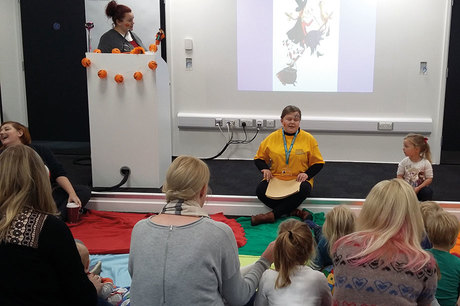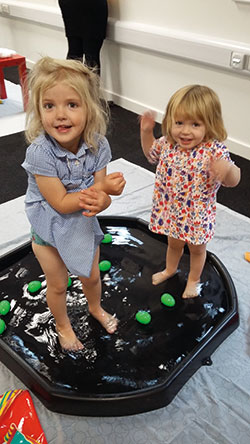
Students can spend 800 hours on a work placement. They are an essential part of training, built into all Early Years Teacher and Qualified Teacher Status programmes, most degrees, and now a key part of all vocational education courses under the Skills Plan. They are the first chance for students to dip a toe into the world of work, engage with real children, and observe child development happening in front of their eyes.
Research has found that on entering placements, students struggle in two key areas: entering an unfamiliar place, which means learning new routines, and in finding their voice – feeling confident enough to make an impact on the practice and activities in the setting.
Students often find it difficult to talk to parents, and so the key worker tends to take that role. For the settings too there is pressure. The new adult on site may be fabulous, but equally may need a high level of support.
Coventry University has taken a radical approach to this issue. We turned the experience on its head: instead of students going out into the community, the community is brought into the university.
Musgrave and Stobbs advocate the importance of pre-placement visits in order to prepare students. We wanted to go one step further and bring these placements into a familiar environment, helping to alleviate one of the students’ main concerns. We wanted to discover whether this would enable more successful outcomes in work placements, with the natural knock-on effect of better experiences for the children.
THE SESSIONS
The idea was simple. Students would work in groups to plan a range of high-quality activities around the theme of a book. We fixed a time when there would be no clash with pre-existing stay-and-play sessions in the town, and made them open to all – parents, carers, childminders and early years settings. Sessions were free, including snacks, while adults could make use of the on-site coffee shop.
The concept was introduced to students on their first week, with the first session held only three weeks later. Their initial reaction was one predominately of trepidation – they had only just started, they were still finding their way round university, and we were then saying that they needed to hit the ground running.
Sessions were held in a newly decorated event room with a new carpet – not ideal, but we managed to persuade the facilities manager of the benefits to the students and the local community. Because the space is used for everything from the freshers’ fayre to business breakfasts, it was necessary to pack everything away at the end of the session – but this in itself was good practice for the students, and they needed to think about the logistics of layout as they prepared the room. Where were they going to put prams? What about access to toilets? Would it be best to place all messy activities together?
Word was sent out through social media and we sat back, hoped, and waited. Amazingly, 18 children attended the first session, ranging from a few months old to nearly five years. By the time we held our ninth and last session for the academic year, 120 children had come through the doors, many of them repeat visitors, and the youngest just six days old. Four sessions were 90 minutes long and five were 60 minutes long. Some attendees were families with multiple children, some were childminders, some were grandparents, some were new mums for whom this was their first foray into the world.
DISCOVERIES
 Students were able to engage directly with the parents and carers. They were able to directly support a woman who was suffering from post-natal depression and for whom this was her first interaction outside the house since becoming a parent.
Students were able to engage directly with the parents and carers. They were able to directly support a woman who was suffering from post-natal depression and for whom this was her first interaction outside the house since becoming a parent.
Kirstie Young, a second-year student on the Early Childhood Development and Learning degree, says, ‘I felt that I already knew a bit about planning as I do a lot with cubs and beavers, but I was nervous about seeing how the parents would react to my ideas.
‘The main thing I learnt was that activities don’t always go to plan. On our first session we used the Dr Seuss book Green Eggs and Ham and had planned to have a tuff spot with water and floating eggs. Each egg had a word in it and the idea was that the children would have to find the eggs with the matching words. The children who came that day were really young – most of them were under three – and as soon as they saw the tray with water in, they climbed straight in. We ended up with loads of kids stripped off and paddling, and none of them even opened the eggs. I learnt that I needed to be open-minded about activities, I need to allow children to explore with an activity rather than telling them what to do with it. And to have spare towels when using water.’
For parents, the experience was also positive. Mark Richardson came when his son Milo was just three months old. He had slight trepidation about students, rather than qualified practitioners, being in charge, but says the presence of experienced practitioner-lecturers was reassuring.
He says, ‘This was one of the first times Milo was in a busy environment with other children and it was good for him to have that stimulation in terms of people and noises. It was a kind of taster session for preparing him for nursery.’
Mum-of-seven Ria Machin attended when her daughter was five weeks old. She says, ‘It was lovely to see enthusiastic young people hands-on with the children. Part of the attraction was definitely because it was free, and that mums could have “respite” knowing the students were stationed at each activity and the children could play and get messy in another space other than home.’
Staff were also able to observe the students before they went on placement. We as lecturers were able to build students’ confidence by scaffolding – playing alongside the student with the child, modelling language and actions.
This was a pilot project, but it will be running again in the next academic year. There will be a few changes – sessions will be advertised from the beginning, and we now know where to advertise. We are making strong links with health visitors, who want to signpost their families to us. Nurseries were invited to attend this year and have asked to do so next year, and already families want to know when the sessions will start again.
CASE STUDY
Lauren Downie (19) is a first year student on the Early Childhood development and Learning degree at Coventry University, who is also blind.
She says, ‘The sessions challenged me to explore non-visual ways of teaching. I know that children learn in different ways and the sessions enabled me to think of how my learning impacted upon them.
‘I was concerned that parents would see me and underestimate what I could teach their children. In the end those parents I did speak to made no mention of my blindness, and the talk was all around the children and their progress.
‘In terms of planning for sessions, I initially asked my seven-year-old cousin what activities he liked. I talked to others in my group about how activities might be adapted. We chose three different books for the three sessions and I led a different activity each time, working in conjunction with another student. For one, I read Room on The Broom in braille, while a colleague used the whiteboard to display the images. Some parents were unaware until they actually looked up that I was using a braille copy, which actually made me feel more confident. We had a sensory activity consisting of jelly in witches’ cauldrons and different creatures in it.
‘As our final session, we had a fancy dress theme, where I played the piano for the songs at the end. It felt brilliant to be able to lead in this way and meant that when I went on placement I was confident to do this again for the nursery children. In fact, I ended up playing to the whole school.
‘I found the sessions invaluable and feel we were very lucky to have them. If I had learnt only through theory and gone into placement without this experience I would have been thrown if they asked me to plan an activity, since I had never done it before.’









